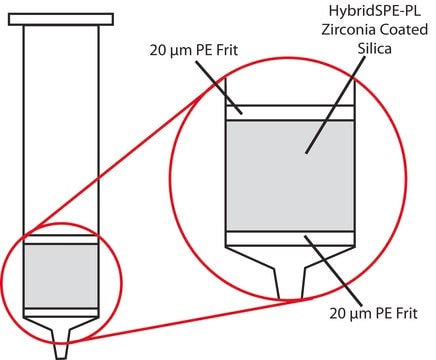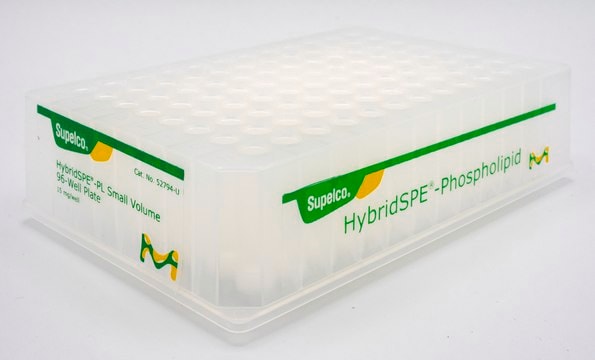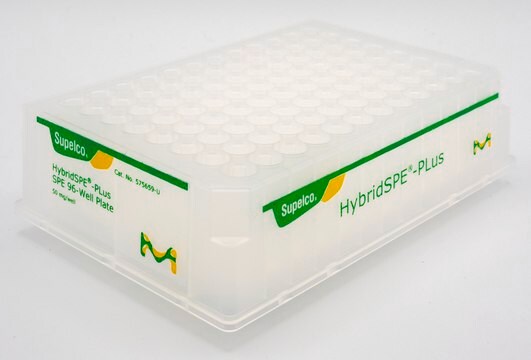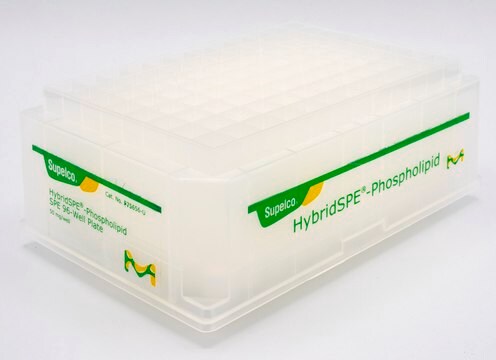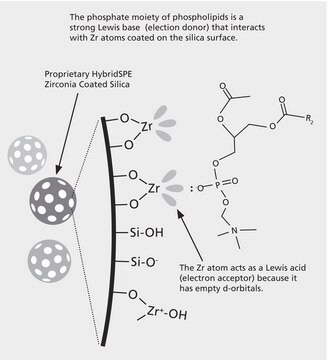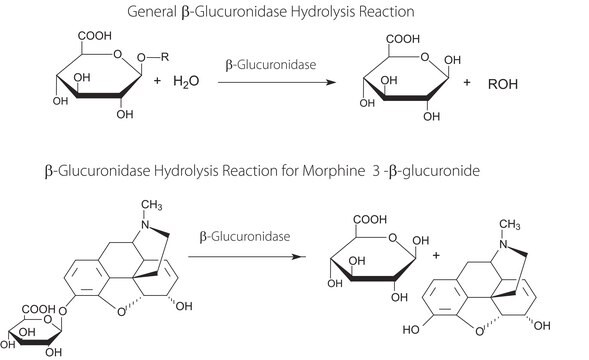55276-U
HybridSPE®-Phospholipid
Cartridge, bed wt. 30 mg, volume 1 mL, pk of 200, polypropylene material (hardware), PE frit (20 μm)
About This Item
Empfohlene Produkte
Materialien
PE frit (20 μm)
polypropylene hardware
Qualitätsniveau
Zusammensetzung
bed wt., 30 mg
Verpackung
pk of 200
Methode(n)
solid phase extraction (SPE): suitable
Volumen
1 mL
Aktive Matrixgruppe
zirconia-based phase
Suchen Sie nach ähnlichen Produkten? Aufrufen Leitfaden zum Produktvergleich
Verwandte Kategorien
Allgemeine Beschreibung
Die „In-Well“- und „In-Cartridge“-Fällungsmethoden sind für die 96-Well-Version von HybridSPE-Phospholipid und die Kartusche von HybridSPE-Phospholipid Ultra verfügbar. Dabei wird zunächst biologisches Plasma oder Serum auf die Mikrotiterplatte bzw. in die Kartusche gegeben und dann gesäuertes Acetonitril, das Fällungsmittel. Nach kurzem Mischen/Vortexen wird Vakuum angelegt. Da die Versionen 96-Well und Ultra-Kartusche zahlreiche hydrophobe Filter/Fritten mit geringer Porosität enthalten, funktioniert der gepackte Filter bzw. die gepackte Fritte als Tiefenfilter und ermöglicht so während der Extraktion die Entfernung von sowohl Phospholipiden als auch gefällten Proteinen. Die standardmäßigen HybridSPE-Phospholipid-Kartuschen erfordern eine „Off-line“-Fällung.
Anwendung
- Less is more: a methodological assessment of extraction techniques for per- and polyfluoroalkyl substances (PFAS) analysis in mammalian tissues.: This study evaluates various extraction techniques, including the use of HybridSPE-Phospholipid, for analyzing PFAS in mammalian tissues. The research highlights the importance of effective phospholipid removal to ensure accurate PFAS quantification (Mertens et al., 2023).
- Rapid analysis of 65 pharmaceuticals and 7 personal care products in plasma and whole-body tissue samples of fish using acidic extraction, zirconia-coated silica cleanup, and liquid chromatography-tandem mass spectrometry.: The study includes HybridSPE-Phospholipid as part of the cleanup process, demonstrating its efficiency in removing phospholipids to improve the detection of pharmaceuticals and personal care products in biological samples (Tanoue et al., 2020).
- Multi LC-MS/MS and LC-HRMS Methods for Determination of 24 Mycotoxins including Major Phase I and II Biomarker Metabolites in Biological Matrices from Pigs and Broiler Chickens.: This research utilizes HybridSPE-Phospholipid for the cleanup of biological matrices, enhancing the accuracy of mycotoxin detection by effectively removing interfering phospholipids (Lauwers et al., 2019).
- Effective phospholipid removal from plasma samples by solid phase extraction with the use of copper (II) modified silica gel cartridges.: The study compares various phospholipid removal techniques, highlighting the performance of HybridSPE-Phospholipid in achieving high phospholipid removal efficiency from plasma samples (Flieger et al., 2017).
- Liquid chromatography mass spectrometry determination of perfluoroalkyl acids in environmental solid extracts after phospholipid removal and on-line turbulent flow chromatography purification.: The research demonstrates the application of HybridSPE-Phospholipid in the removal of phospholipids from environmental solid extracts, facilitating the accurate measurement of perfluoroalkyl acids (Mazzoni et al., 2016).
Leistungsmerkmale und Vorteile
- Vereint die Einfachheit der Proteinfällung mit der Selektivität der Festphasenextraktion (SPE) durch die gezielte Entfernung von Phospholipiden
- Reduziert die Ionenunterdrückung durch vollständige Entfernung der Phospholipide und gefällten Proteine
- Zwei- bis dreistufige generische Methode
- Geringe bis keine Methodenentwicklung
- Als 96-Well-Platten und 1 mL große Kartuschen erhältlich
Rechtliche Hinweise
Lagerklassenschlüssel
11 - Combustible Solids
WGK
WGK 3
Flammpunkt (°F)
Not applicable
Flammpunkt (°C)
Not applicable
Choose from one of the most recent versions:
Besitzen Sie dieses Produkt bereits?
In der Dokumentenbibliothek finden Sie die Dokumentation zu den Produkten, die Sie kürzlich erworben haben.
Artikel
We are presenting an article focusing on ion-suppression and phospholipid contamination and some of their major causes and difficulties.
Protokolle
A simple method to enrich phospholipids from plasma samples, involving a HybridSPE-PPT 96-well plate that both retains phospholipids and removes precipitated proteins.
Unser Team von Wissenschaftlern verfügt über Erfahrung in allen Forschungsbereichen einschließlich Life Science, Materialwissenschaften, chemischer Synthese, Chromatographie, Analytik und vielen mehr..
Setzen Sie sich mit dem technischen Dienst in Verbindung.